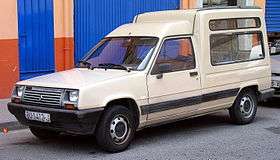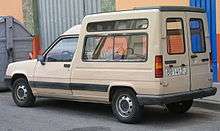Renault Express
| Express | |
|---|---|
 | |
| Overview | |
| Also called | Extra, Rapid |
| Production | 1985–2002 |
| Body and chassis | |
| Body style | Van |
| Dimensions | |
| Wheelbase | 2,580 mm (101.6 in) |
| Length | 4,056 mm (159.7 in) |
| Width | 1,566 mm (61.7 in) |
| Height | 1,776 mm (69.9 in) |
| Chronology | |
| Predecessor | Renault R4 F6 |
| Successor | Renault Kangoo |
The Renault Express is a panel van of the French automobile manufacturer Renault, which in July 1985 as the successor to the R4 F6 has been placed on the market. It base on the 2nd Renault 5. It was commercialized in some European countries as the Renault Extra (UK and Ireland),Renault Rapid (mainly German speaking countries) or Renault Express (in France, Spain, Austria, Switzerland, Italy, Japan,Taiwan). From 1996 to 2002 the Express was produced for South America at Nordex in Uruguay.
Structure
Technically the Express was based on the second generation of the Renault 5. With this model, it is also - except for a few stylistic changes - to the A-pillar equal. Also dashboard, chassis and the two front doors.
Special features of the Express opposite the Renault 5 was the one of the lengthened by about 15 cm wheelbase, the raised roof over the driver's cab and the box structure behind the B-pillar. The vehicle was a non- or partially glazed vans version with up to two seats, as a combi with five seats, as pickup and standard factory as handicapped vans or with various special bodies (refrigerated trucks, workshop vehicles available, etc.).
The Renault Express gave it both as a panel van with two sides battered double doors in the rear, as well as having a large, upward-opening tailgate. As with its predecessors Renault 4 F4 and F6 all wheels were the Renault Express individually suspended: the front of MacPherson struts and wishbones and rear to swing with torsion bars, while similar vehicles - such as the VW Caddy or Opel Combo etc. - Often with a rear live axle were fitted to leaf springs.
Model Series
The facelift was carried out - as in Renault usual - in several so-called phases.
The first version (Phase 1) was built by the middle of 1985 until the summer 1991st Here Renault first offered a panel van with a 1,6l- diesel engine (40 kW / 54 hp), while the gasoline engines came from the Renault 5 for use. Discoverable ours is the almost vertical headlamps.
In summer 1991 a revision was carried out for Phase 2. The engine range changed because now partially machines from Renault Clio were taken. Added to this was, among other things, a 1.9l diesel engine with 47 kW (64 hp). This engine with the label "F8Q" will be modified to this day in various models of Renault and Nissan use. Discoverable was ours at the modernized radiator grill, which was usually kept in gray plastic and aerodynamically slightly cheaper.
The phase 3 of the model was from early 1994 until its replacement by the Kangoo built. The biggest differentiators were looking high quality materials, the radiator grille in body color and the slightly revised taillights. At extra costs was for ours airbag available. Not only the safety equipment was upgraded, the comfort features such. B. by Central with remote control. In phase 3, the 1.6l diesel engine fell off and reduced by a 40 kW (54 PS) 1.9l diesel engine has been replaced.
Engine
| Model | Type | cylinder capacity cm³ | Max. power kW (hp) / rpm. | Torque Nm / rpm. | 0-100 km/t sec. | Year |
|---|---|---|---|---|---|---|
| Petrol | ||||||
| 1.0 | C1C | 956 | 31 (42) / 4400 | 63 / 2500 | 1986 − 1991 | |
| 1.1 | C1E | 1108 | 33 (45) / 4400 | 85 / 2000 | 20,1 | 1986 − 1991 |
| 1.2 | E5F | 1171 | 40 (55) / 6000 | 84 / 3500 | 16,5 | 1991 − 1997 |
| 1.2 | C3G | 1239 | 40 (54) / 5300 | 90 / 4800 | 16,5 | 1995 − 1997 |
| 1.4 | C2J | 1397 | 50 (68) / 5250 | 104 / 3500 | 14,5 | 1986 − 1992 |
| 1.4 | C3J | 1390 | 44 (60) / 5250 | 101 / 2750 | 1986 − 1992 | |
| 1.4 | E7J | 1390 | 55 (75) / 5600 | 109 / 4000 | 1991 − 1997 | |
| 1.5 | C3L | 1565 | 43 (58) / 5000 | 100 / 3500 | 14,5 | 1996 − 2002 |
| Diesel | ||||||
| 1.6 D | F8M | 1596 | 40 (55) / 4800 | 102 / 2250 | 17,8 | 1986 − 1991 |
| 1.9 D | F8Q | 1870 | 40 (55) / 3900 | 123 / 2250 | 18,5 | 1995 − 1997 |
| 1.9 D | F8Q | 1870 | 47 (64) / 4500 | 118 / 2250 | 16,5 | 1991 − 1997 |
- Phase I Front
 Express I Rear
Express I Rear Phase I Pickup in Taiwan by Sanfu Motor
Phase I Pickup in Taiwan by Sanfu Motor Phase II
Phase II Phase II III Rear
Phase II III Rear Phase III
Phase III Phase III
Phase III Phase III Rear
Phase III Rear- Phase III
| Wikimedia Commons has media related to Renault Express. |